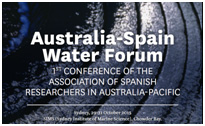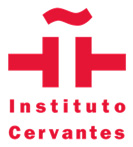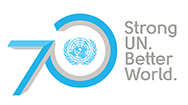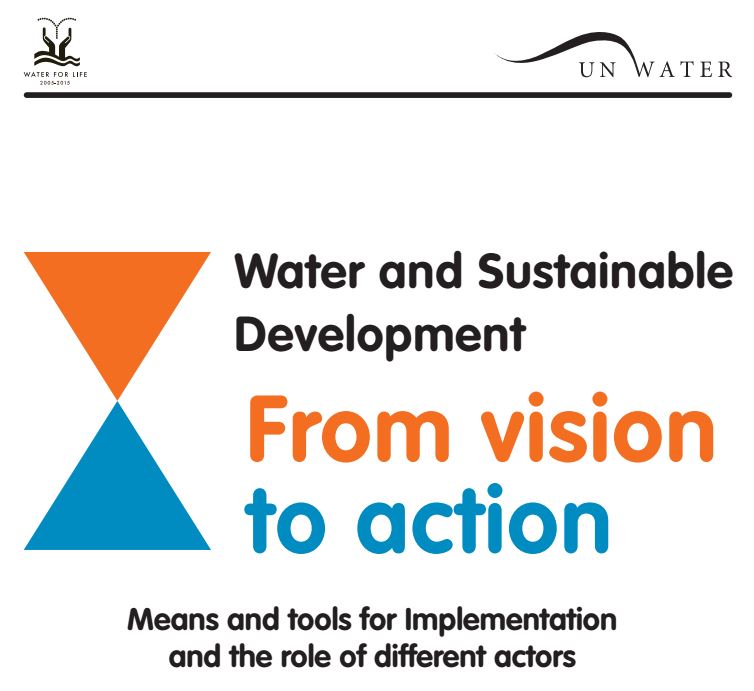- ON THE DECADE
- THE DECADE'S CAMPAIGN
- REPORTING ON PROGRESS
- THE DECADE'S PROGRAMMES
- FOCUS AREAS
-
- Access to sanitation
- Financing water
- Gender and water
- Human right to water
- Integrated Water Resources Management
- Transboundary waters
- Water and cities
- Water and energy
- Water and food security
- Water and sustainable development
- Water and the green economy
- Water cooperation
- Water quality
- Water scarcity
- FOCUS REGIONS
- RESOURCES FOR
- UN e-RESOURCES
Thematic information briefs
Water and Sustainable Development
For the purposes of the Conference and in preparation for World Water Day 2015, the UN-Water Decade Programme on Advocacy and Communication (UNW-DPAC) has produced a series of information briefs on the implementation of the different sub-themes of current proposals of the water related sustainable development goals.
-
Information brief on Water and Sustainable Development
Water is a finite resource that is fundamental to human well-being and only renewable if well managed. Smart water management is a pre-condition of sustainable development. Managed efficiently, water plays a vital role in strengthening the resilience of social, economic and environmental systems in the face of rapid and unpredictable changes. This information brief presents the role of water in achieving sustainable development. -
Information brief on Implementing improvements in water quality and protecting ecosystem services
Water is essential for life. The amount of freshwater on Earth is limited, and its quality is under constant pressure. Preserving the quality of freshwater is important for the drinking-water supply, food production and recreational water use. Water quality can be compromised by the presence of infectious agents, toxic chemicals, and radiological hazards. This information brief presents why water quality matters, as well as the current commitments, challenges and tools for implementation in relation to water quality and protection of ecosystem services. -
Information brief on Implementing Water, Sanitation and Hygiene (WASH)
One of the world's most urgent issues is lack of safe water, sanitation and hygiene. Water-related improvements are crucial to meet the development goals, reduce child mortality, and improve health in a sustainable way. In July 2014 the UN Open Working Group (OWG) proposed a Sustainable Development Goal (SDG) to "Ensure availability and sustainable management of water and sanitation for all". This information brief presents the current commitments to progress, challenges and tools for implementation in relation to WASH. -
Information brief on Implementing Risk Management in Water and Sanitation
Over the centuries, societies around the world have and learned to coexist alongside the risk of natural disasters. Today's climatic changes mean that we live in a world where these risks are aggravated. Additionally, a globalised economy brings with it the risk of socioeconomic disasters created by fluctuations in the global financial market. By developing solutions to manage increasing risk we can help protect the poor and vulnerable communities who bear the brunt of the effects of natural disasters. We need new strategies and a better capacity to absorb change. This information brief presents the need to manage water risks, as well as the current commitments, challenges and tools for implementation in relation to risk management in water and sanitation. -
Information brief on Implementing Water Resources Management
Freshwater is central to all development efforts. Yet it faces growing pressures across the world – from urbanization and overconsumption, to underinvestment and lack of capacity, poor management and waste, and the demands of agriculture, energy and food production. While it is generally considered that there is enough freshwater on the planet for 7 billion people it is distributed unevenly and too much of it is wasted, polluted and unsustainably managed. This information brief presents the current commitments, challenges and tools for implementation in relation to water resources management.
Water and Energy
For the purposes of the Conference and in preparation for World Water Day 2014, the UN-Water Decade Programme on Advocacy and Communication (UNW-DPAC) has produced a series of information briefs on different issues and tools.
-
Information brief on Water and Energy

UNW-DPAC. January 2014
Water and energy are basic components of life, economic growth and human progress. This is a reality for the poor as securing access to both water and energy is still the cornerstone of alleviating poverty and breaking up the vicious circles and backwardness it creates. As well as for those already on the road towards development, where most of the growing demand for energy and food arises, and where making water and energy more abundant and accessible is an integral part of economic progress that comes through important challenges such as matching limited water and energy supplies with increasing demands and managing food security… -
Information brief on Water and Energy Efficiency

UNW-DPAC. January 2014
Historically, efforts to improve water and energy (W&E) efficiency have been widely pursued separately. Improving efficiency from both the supply and the demand sides would allow countries to reduce resource scarcity and maximize the benefits provided by existing W&E infrastructure. Water efficiency is a multi faceted concept. It means “doing more and better with less” by obtaining more value with the available resources, by reducing the resource consumption and reducing the pollution and environmental impact of water use for the production of goods and services at every stage of the value chain and of water service provision… -
Information brief on Securing Access to Water and Energy

UNW-DPAC. January 2014
Regardless of their stage of development, its location and even their resource endowments, every society faces problems with securing access to water and energy. For the poorest, where fulfilling the Millennium Development Goals is still pending, securing access to both water and energy is the cornerstone of alleviating poverty and breaking up the vicious circles of poverty and backwardness. In transition economies, making water and energy more abundant and accessible is an integral part of economic progress that comes about with important challenges such as matching limited water and energy supplies with increasing demands and managing food security… - Information brief on Water and Energy Sustainability

UNW-DPAC. January 2014
Development is a double-edged sword. Reducing poverty, triggering economic growth and building up a more inclusive society are outstanding collective achievements that come with new and bigger social and environmental challenges and with the need to reconcile the different objectives in the continuous quest of a sustainable development path . Success in economic growth requires harnessing the potential of ecosystems to satisfy the demands of water and energy which are essential for life as well as for the functioning of the many production and consumption processes where water and energy intervene as irreplaceable inputs…
Water cooperation
For the purposes of the International Year of Water Cooperation (IYC) and the International Annual UN-Water Zaragoza Conference 2012/2013 "Preparing for the 2013 International Year. Water Cooperation: Making it Happen!" which took place in Zaragoza, Spain, from 8 to 10 January 2013, UNW-DPAC produced a series of information briefs on different issues and tools on water cooperation.
-
Information brief on water cooperation
UNW-DPAC. January 2013
This brief provides information on water cooperation: why is this theme important? What are the main challenges and benefits? Which tools can be used to promote water cooperation? -
Information brief on financing
UNW-DPAC. January 2013
This brief provides information on financing water cooperation: what are the main challenges in financing water cooperation processes? Which tools are available for financing water cooperation? What are the main sources? -
Information brief on Information Sharing and Joint Assessments
UNW-DPAC. January 2013
This brief provides information on information sharing and joint assessments: how can they contribute to water cooperation processes at basin levels and in cities? The brief also highlights some conditions for success and some examples. -
Information brief on Alternative Dispute Resolution
UNW-DPAC. January 2013
This brief provides information on Alternative Dispute Resolution methods: what are the key approaches and techniques? Which skills are required to apply these techniques? The brief also highlights some quick facts and practical examples related to the theme. -
Information brief on Legal Frameworks and Institutional Arrangements
UNW-DPAC. January 2013
This brief provides information on legal frameworks and institutional arrangements: in what way do they contribute to water cooperation processes at different levels? The brief highlights a number of key legal frameworks and institutional arrangements and outlines some conditions for success. Some quick facts and examples are also included.
Water and the Green Economy
For the purposes of the International UN-Water Conference "Water in the Green Economy in Practice: Towards Rio+20", 3-5 October 2011, Zaragoza, Spain, UNW-DPAC has produced a series of information briefs on different issues and tools addressed by the conference. The UN-Water conference identified four priority water-related issues where this change needs to take place: for cities, watersheds, agriculture and industries. The issues information briefs introduce the main challenges, opportunities and key facts related to each of the issues identified. The briefs also outline a set of practices and approaches for transitioning to the green economy as highlighted by the organisations participating in the conference. These approaches are illustrated with case studies featured in the conference. The tools information briefs introduce the main challenges, opportunities and key facts related to each of the tools identified. The briefs also outline a set of practices and approaches for transitioning to the green economy as highlighted by the organisations participating in the conference.
-
Information brief on water and industry in the Green Economy
UNW-DPAC.September 2011 - Information brief on water and agriculture in the Green Economy
UNW-DPAC. September 2011 -
Information brief on water and cities in the Green Economy
UNW-DPAC. September 2011 -
Information brief on watersheds and aquifers in the Green Economy
UNW-DPAC. September 2011 -
Information brief on water and technology in the transition to the Green Economy
UNW-DPAC. September 2011 -
Information brief on water and capacity development in the transition to the Green Economy
UNW-DPAC. September 2011 -
Information brief on water financing in the transition to the Green Economy
UNW-DPAC. September 2011
Human right to water and sanitation
-
The human right to water and sanitation

UNW-DPAC. June 2011
This document presents the current situation and some examples illustrating how the human right to water and sanitation is being implemented in practice. -
UN Milestones

UNW-DPAC. June 2011
This document presents the UN historical background and evolution of recognition of the human right to water and sanitation.
Water and cities
Information notes produced by UNW-DPAC for the International Conference “Sustainable Water Management in Cities: Engaging stakeholders for effective change and action”, which took place in Zaragoza, Spain, from 13 to 17 December 2010. These information notes also served for the preparation of World Water Day 2011.
-
Information brief on water and cities

UNW-DPAC. December 2010
What are the main challenges regarding water issues in cities? Where is the situation most pressing? Who is most affected? When are changes being realized? Why this conference? This brief tries to respond to these and other questions you may have. -
Water quality and sanitation

UNW-DPAC. December 2010
Rapid urbanisation brings along several challenges related to water quality issues and sanitation. One out of four urban dwellers does not have access to improved sanitation facilities. 90% of all waste water in developing countries is discharged untreated, polluting rivers, lakes and seas. How cities are coping with these challenges? -
Cities coping with water uncertainties

UNW-DPAC. December 2010
Today, many cities are facing severe water uncertainties, such as floods, droughts and upstream activities on transboundary rivers. Climate change and water-related disasters will place increasing demands on urban systems and will result in increased migration to urban areas. The most vulnerable are the urban poor, since they often live in hazardous locations, such as flood plains, and in poor quality housing. -
Water and urbanisation

UNW-DPAC. December 2010
Half of humanity now lives in cities and, within two decades, nearly 60% of the world's population will be urban dwellers. Urban growth is most rapid in the developing world, where cities gain an average of 5 million residents every month. In Africa and Asia, the urban population will double between 2000 and 2030. Cities are growing because of: natural increase in urban population (50%), reclassification of rural areas as urban areas (25%) and rural-to-urban migration. The exploding urban population growth creates unprecedented challenges, among which provision for water and sanitation have been the most pressing and painfully felt when lacking. -
Cities and their rural surroundings. The urban-rural interface

UNW-DPAC. December 2010
Cities can no longer be treated as distinct spaces unconnected to the regions surrounding them. The functioning of urban settlements depends on land in the surrounding rural areas for food and water supply, waste disposal, recreational value and the growth of settlements. In order to sustain both urban and rural livelihoods and ecosystems, there is a need for the sustainable management of the resources requirements of urban and peri-urban areas.
>> UNW-DPAC home
>> In the news
>> What we do
>> Where we are
>> Visual identity
>> Events Agenda
>> Internship programme
>> Media Programme
>> UN Water Dialogue Series in Casa Solans
>> 'Water for Life' UN-Water Best Practices Award
>> 'Water for Life' Voices Exhibit and Campaign
>> Zaragoza Conferences
>> World Conference Series
>> Bimonthly Publications Review
>> Information briefs
>> Readers
>> Special reports
>> Water facts and figures
>> Thematic video series
>> Conference video series
>> UNW-DPAC external evaluation of 2011-2015 workplan [ - 209 KB]
- 209 KB]
>> Biennial Report 2014-2015 [ - 1.18 MB]
- 1.18 MB]
>> Biennial Report 2012-2013 [ - 1.18 MB]
- 1.18 MB]
>> Biennial Report 2010-2011 [ - 566 KB]
- 566 KB]
>> Annual Report 2009
[ - 1.05 MB]
- 1.05 MB]
Copyright | Terms of use | Privacy notice | Site Index | Fraud alert | Help











